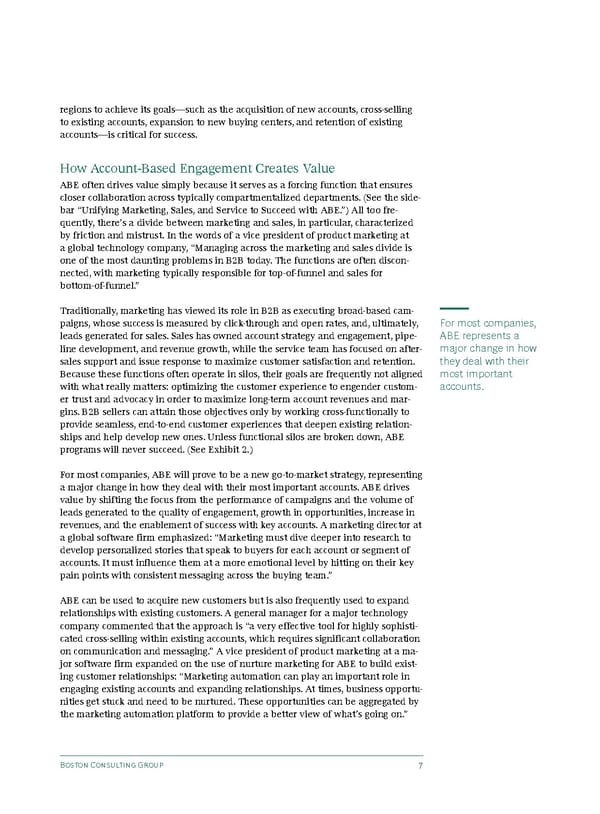regions to achieve its goals—such as the acquisition of new accounts, cross-selling to existing accounts, expansion to new buying centers, and retention of existing accounts—is critical for success. How Account-Based Engagement Creates Value ABE often drives value simply because it serves as a forcing function that ensures closer collaboration across typically compartmentalized departments. (See the side- bar “Unifying Marketing, Sales, and Service to Succeed with ABE.”) All too fre- quently, there’s a divide between marketing and sales, in particular, characterized by friction and mistrust. In the words of a vice president of product marketing at a global technology company, “Managing across the marketing and sales divide is one of the most daunting problems in B2B today. The functions are often discon- nected, with marketing typically responsible for top-of-funnel and sales for bottom-of-funnel.” Traditionally, marketing has viewed its role in B2B as executing broad-based cam- paigns, whose success is measured by click-through and open rates, and, ultimately, For most companies, leads generated for sales. Sales has owned account strategy and engagement, pipe- ABE represents a line development, and revenue growth, while the service team has focused on after- major change in how sales support and issue response to maximize customer satisfaction and retention. they deal with their Because these functions often operate in silos, their goals are frequently not aligned most important with what really matters: optimizing the customer experience to engender custom- accounts. er trust and advocacy in order to maximize long-term account revenues and mar- gins. B2B sellers can attain those objectives only by working cross-functionally to provide seamless, end-to-end customer experiences that deepen existing relation- ships and help develop new ones. Unless functional silos are broken down, ABE programs will never succeed. (See Exhibit 2.) For most companies, ABE will prove to be a new go-to-market strategy, representing a major change in how they deal with their most important accounts. ABE drives value by shifting the focus from the performance of campaigns and the volume of leads generated to the quality of engagement, growth in opportunities, increase in revenues, and the enablement of success with key accounts. A marketing director at a global software firm emphasized: “Marketing must dive deeper into research to develop personalized stories that speak to buyers for each account or segment of accounts. It must influence them at a more emotional level by hitting on their key pain points with consistent messaging across the buying team.” ABE can be used to acquire new customers but is also frequently used to expand relationships with existing customers. A general manager for a major technology company commented that the approach is “a very effective tool for highly sophisti- cated cross-selling within existing accounts, which requires significant collaboration on communication and messaging.” A vice president of product marketing at a ma- jor software firm expanded on the use of nurture marketing for ABE to build exist- ing customer relationships: “Marketing automation can play an important role in engaging existing accounts and expanding relationships. At times, business opportu- nities get stuck and need to be nurtured. These opportunities can be aggregated by the marketing automation platform to provide a better view of what’s going on.” Boston Consulting Group 7
 BCG moving beyond ABM to account based engagement Page 8 Page 10
BCG moving beyond ABM to account based engagement Page 8 Page 10